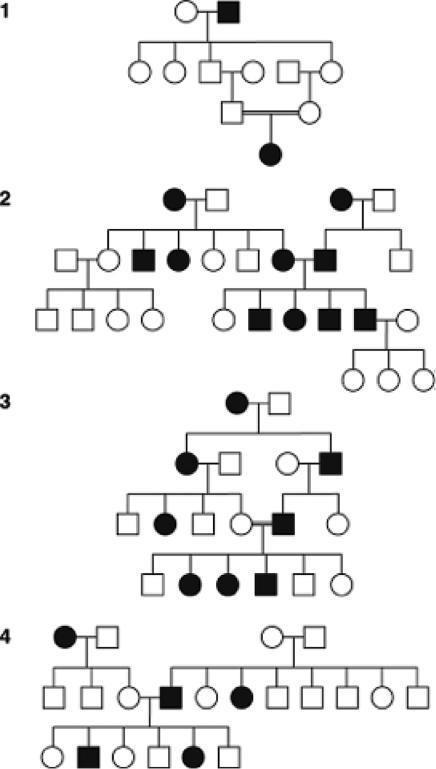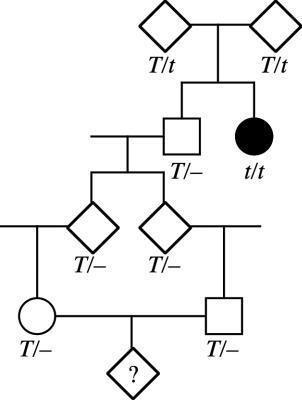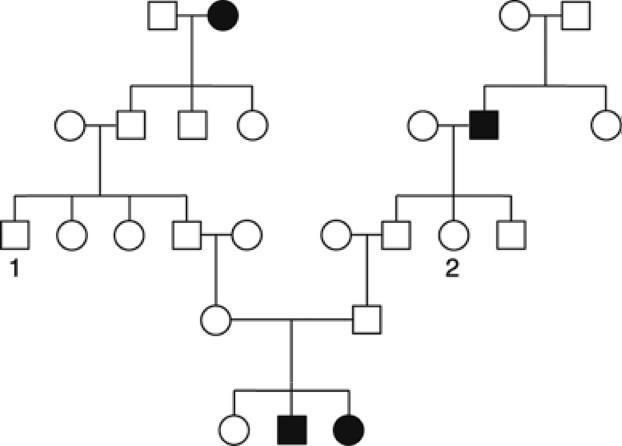
6 minute read
CHAPTER 2 Single-Gene Inheritance
from Solution manual for introduction to genetic analysis 11th edition griffiths wessler carroll doebley
The five unusual plants are most likely due either to human error in classification or to contamination. Alternatively, they could result from environmental effects on development. For example, too little water may have prevented the seedpods from becoming winged, even though they are genetically winged.
50. The accompanying pedigree is for a rare but relatively mild hereditary disorder of the skin.
Advertisement
a. How is the disorder inherited? State reasons for your answer.
b. Give genotypes for as many individuals in the pedigree as possible. (Invent your own defined allele symbols.)
c. Consider the four unaffected children of parents III-4 and III-5. In all four-child progenies from parents of these genotypes, what proportion is expected to contain all unaffected children?
Answer: a. The disorder appears to be dominant because all affected individuals have an affected parent. If the trait was recessive, then I-1, II-2, III-1, and III-8 would all have to be carriers (heterozygous for the rare allele) b. Assuming dominance, the genotypes are:
I: d/d, D/d
II: D/d, d/d, D/d, d/d
III: d/d, D/d, d/d, D/d, d/d, d/d, D/d, d/d
IV: D/d, d/d, D/d, d/d, d/d, d/d, d/d, D/d, d/d c. The mating is D/d ¥ d/d. The probability of an affected child (D/d) equals 1 /2, and the probability of an unaffected child (d/d) equals 1 /2 Therefore, the chance of having four unaffected children (since each is an independent event) is 1 /2 ¥ 1 /2 ¥ 1 /2 ¥ 1 /2 = 1 /16. a. For each pedigree, state whether the abnormal condition is dominant or recessive. Try to state the logic behind your answer. b. For each pedigree, describe the genotypes of as many persons as possible.
51. Four human pedigrees are shown in the accompanying illustration. The black symbols represent an abnormal phenotype inherited in a simple Mendelian manner.
Answer: a. Pedigree 1: The best answer is recessive because two unaffected individuals had affected progeny. Also, the disorder skips generations and appears in a mating between two related individuals. b. Genotypes of pedigree 1:
Pedigree 2: The best answer is dominant because two affected parents have an unaffected child. Also, it appears in each generation, roughly half the progeny are affected, and all affected indi-viduals have an affected parent.
Pedigree 3: The best answer is dominant, for many of the reasons stated for pedigree 2. Inbreed-ing, while present in the pedigree, does not allow an explanation of recessive because it cannot account for individuals in the second or third generations.
Pedigree 4: The best answer is recessive. Two unaffected individuals had affected progeny.

Generation I: A/–, a/a
Generation II: A/a, A/a, A/a, A/–, A/–, A/a
Generation III: A/a, A/a
Generation IV: a/a
Genotypes of pedigree 2:
Generation I: A/a, a/a, A/a, a/a
Generation II: a/a, a/a, A/a, A/a, a/a, a/a, A/a, A/a, a/a
Generation III: a/a, a/a, a/a, a/a, a/a, A/
Generation IV: a/a, a/a, a/a
Genotypes of pedigree 3:

Generation I: A/–, a/a
Generation II: A/a, a/a, a/a, A/a
Generation III: a/a, A/a, a/a, a/a, A/a, a/a
Generation IV: a/a, A/a, A/a, A/a, a/a, a/a
Genotypes of pedigree 4:
Generation I: a/a, A/–, A/a, A/a
Generation II: A/a, A/a, A/a, a/a, A/
, A/
, A/
, A/a, a/a
, a/a, A/
Generation III: A/a, a/a, A/a, A/a, a/a, A/a
, A/
, A/
, A/
, A/
52. Tay-Sachs disease is a rare human disease in which toxic substances accumulate in nerve cells. The recessive allele responsible for the disease is inherited in a simple Mendelian manner. For unknown reasons, the allele is more common in populations of Ashkenazi Jews of eastern Europe. A woman is planning to marry her first cousin, but the couple discovers that their shared grandfather’s sister died in infancy of Tay-Sachs disease a. Draw the relevant parts of the pedigree, and show all the genotypes as completely as possible. b. What is the probability that the cousins’ first child will have Tay-Sachs disease, assuming that all people who marry into the family are homozygous normal?
Answer: a. The pedigree is b. The probability that the child of the two first cousins will have Tay-Sachs disease is a single calculation, first assessing the probability that the shared grandfather is a carrier (2/3, his parents were carriers) and then following the probabilities through to the male and female in question. If the grandfather is a carrier, then each of his children had a 1/2 probability of receiving the mutant allele This consideration is again true for passing the allele to the male and female in question.
Finally, both the male and female in question must have the recessive allele if an affected child is to be born. If both are carriers, then that outcome would have a 1/4 probability.
Thus, (2/3)(1/2)4(1/4) = 1/96.
To understand the probabilities of the first two events, see also the discussion for part 2 in prob-lem 8 of this chapter.
53. The following pedigree was obtained for a rare kidney disease a. Deduce the inheritance of this condition, stating your reasons. b. If persons 1 and 2 marry, what is the probability that their first child will have the kidney disease?
Answer: a. Autosomal recessive: affected individuals inherited the trait from unaffected parents and a daughter inherited the trait from an unaffected father. b. Both parents must be heterozygous to have a 1 /4 chance of having an affected child. Parent 2 is heterozygous, since her father is homozygous for the recessive allele and parent 1 has a 1 /2 chance of being heterozygous, since his father is heterozygous because 1’s paternal grandmoth-er was affected. Overall, 1 ¥ 1/2 ¥ 1/4 = 1 8. a. Is this pedigree compatible with the mode of inheritance for Huntington disease mentioned in the chapter? b. Consider two newborn children in the two arms of the pedigree, Susan in the left arm and Alan in the right arm. Study the graph in Figure 2-24 and form an opinion on the likelihood that they will develop Huntingtondisease. Assume forthesakeofthe discussion that parents havechildren at age 25.

54. This pedigree is for Huntington disease, a late-onset disorder of the nervous system. The slashes indicate deceased family members.

Answer: a. Yes. It is inherited as an autosomal dominant trait. b. Susan is highly unlikely to have Huntington’s disease Her great-grandmother (individual II-2) is 75 years old and has yet to develop it, when nearly 100 percent of people carrying the allele will have developed the disease by that age If her great-grandmother does not have it, Susan cannot inherit it.
Alan is somewhat more likely than Susan to develop Huntington’s disease His grandfather (individual III-7) is only 50 years old, and approximately 20 percent of the people with the allele have yet to develop the disease by that age Therefore, it can be estimated that the grandfather has a 10percent chance of being a carrier (50-percent chance he inherited the allele from his father ¥ 20percent chance he has not yet developed symptoms). If Alan’s grandfather eventually devel-ops Huntington’s disease, then there is a probability of 50 percent that Alan’s father inherited it from him, and a probability of 50 percent that Alan received that allele from his father. There-fore, Alan has a 1/10 ¥ 1 2 ¥ 1 2 = 1/40 current probability of developing Huntington’s disease and a 1/2 ¥ 1/2 / / = 1/4 probability if his grandfather eventually develops it.
55. Consider the accompanying pedigree of a rare autosomal recessive disease, PKU a. List the genotypes of as many of the family members as possible. b. If persons A and B marry, what is the probability that their first child will have PKU? c. If their first child is normal, what is the probability that their second child will have PKU? d. If their first child has the disease, what is the probability that their second child will be unaffected?

(Assume that all people marrying into the pedigree lack the abnormal allele.)
Answer: a. Assuming the trait is rare, expect that all individuals marrying into the pedigree do not carry the disease-causing allele
I: P/P, p/p, p/p, P/P
II: P/P, P/p, P/p, P/p, P/p
III: P/P, P/–, P/–, P/P
IV: P/–, P/– b. For their child to have PKU, both A and B must be carriers and both must donate the recessive allele.
The probability that individual A has the PKU allele is derived from individual II-2. II-2 must be P/p since her father must be p/p Therefore, the probability that II-2 passed the PKU allele to individual III-2 is 1 /2. If III-2 received the allele, the probability that he passed it to individual IV-1 (A) is 1 /2 Therefore, the probability that A is a carrier is 1 /2 ¥ 1 2 = 1 /4 The probability that individual B has the allele goes back to the mating of II-3 and II-4, both of whom are heterozygous. Their child, III-3, has a 2 3 probability of having received the PKU allele and a probability of 1/2 of passing it to IV-2 (B). Therefore, the probability that B has the PKU allele is 2 /3 ¥ 1 /2 = 1 /3.
If both parents are heterozygous, they have a 1 4 chance of both passing the p allele to their child. p(child has PKU) = p(A is P/p) ¥ p(B is P/p) ¥ p(both parents donate p)



